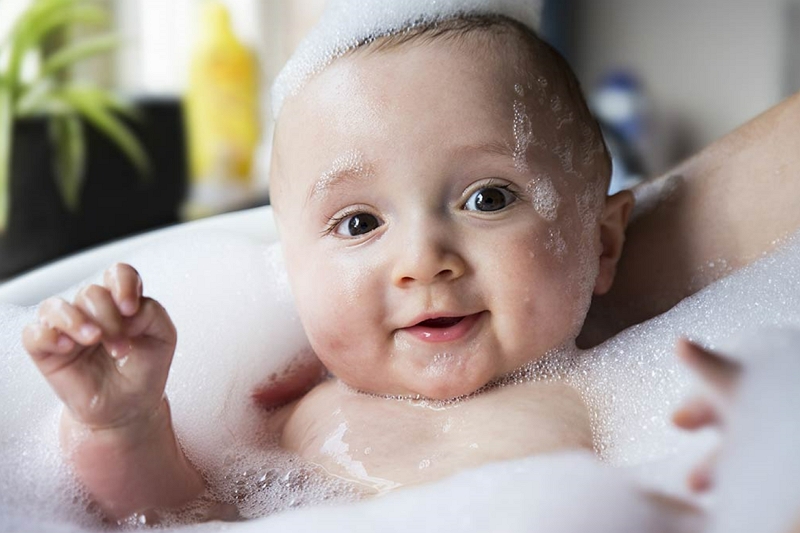How to sponge bath a baby? A sponge bath is a great way to keep your baby clean when you can’t take them into the shower with you.

Here are the steps to give your baby a sponge bath:
* Fill a sink or basin with warm water and add soap.
* Submerge the baby up to their neck in soapy water.
* Using a soft cloth or sponge, gently wash all of their body, paying special attention to dirty areas and their genital area.
* Rinse off all of the soap with fresh warm water.
* Gently pat your baby dry with a towel.
Remember not to get the umbilical cord wet while bathing your baby. If it gets wet, just dry it off as best as you can. After your baby is dry, gently massage them with a moisturizing lotion to keep their skin supple and soft.
How often should I bathe my baby?
There is no one right answer to this question, as it depends on a variety of factors including your baby’s age, skin type and climate. In general, newborns should be bathed every other day, while babies over six months can go up to three or four days without a bath.
If your baby has particularly sensitive skin, you may need to bathe them more often. It’s also important to make sure that your baby is completely dry after their bath, as they can easily catch a cold if they’re not completely dry.
Some parents choose to give their baby sponge baths until they can sit up unassisted, which usually happens around six months old.
This involves washing the baby’s body with a wet washcloth or sponge and then drying the baby off. Make sure to avoid getting water in your baby’s eyes, ears and face, especially if they are under six months old.
If you do choose to bathe your infant, make sure the room is warm beforehand so that it doesn’t get too chilly for them after their bath. You’ll also want to have everything ready before placing them in the tub so that you don’t need to leave them unattended while looking for something.
This includes having clean towels at hand along with any other items such as soap or shampoo within arm’s reach of where you will be bathing the baby. The temperature of both the water and air should be comfortable for an adult but not overly hot since babies are more sensitive to heat.
A baby tub is a great option for bathing your infant and can be purchased at most major retailers in the infant section of the store along with other items such as towels, washcloths, soap and shampoo.
These tubs are designed specifically for infants and will feature an insert that allows you to place them in a reclining position which is much safer than trying to use a regular bathtub or sink where they could easily slip out of your hands. It’s also easier on you since it’s just one hand required instead of two when using a regular bathtub.
Make sure that any soaps or shampoos used during the bath have been approved by paediatricians as safe for infants up until six months old. You can also use baby oil or a moisturizer to prevent their skin from becoming too dry after their bath.
How do you clean a disgusting plastic bathtub?
You could try using a commercial cleaner, but those often contain harsh chemicals that can damage your tub. A better option is to make your natural cleaner using ingredients you probably have in your kitchen.
To make the cleaner, mix one cup of baking soda with one-half cup of vinegar. Pour the mixture into a spray bottle and spritz it onto the surface of the bathtub. Let it sit for about five minutes before scrubbing it clean with a brush or sponge. Rinse thoroughly with water.
This homemade cleaner is safe for use on all types of plastic bathtubs and will remove any dirt or grime build-up quickly and easily. Plus, it’s much cheaper than buying a commercial cleaner!
What is the best cleaner for plastic bathtubs?
There are a few different types of cleaners that can be used on plastic bathtubs. Abrasive cleaners, like Comet or Soft Scrub, should not be used because they can scratch the surface of the tub. Instead, use a non-abrasive cleaner like dish soap or Mr Clean Magic Eraser.
If there is a build-up of dirt and grime, you can make your cleaner by mixing one part vinegar with three parts water. Be sure to rinse the tub thoroughly after cleaning it to remove any residue from the vinegar solution.
If you have a fabric shower curtain liner, it is important to clean it regularly to prevent mildew growth. The best way to clean it is by taking it down and washing it in the washing machine with hot water and detergent.
Be sure to air-dry it completely before putting it back up. If you don’t have a fabric shower curtain liner, you can spray the curtain with a disinfectant or diluted bleach solution to help kill any bacteria or mildew.
Finally, be sure to clean your bathmat regularly. The best way to do this is by shaking it out outside and spraying it with a hose. You can also wash it in the washing machine if needed. Bathmats can harbor a lot of dirt and bacteria, so it’s important to keep them clean!
